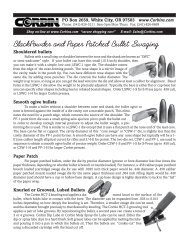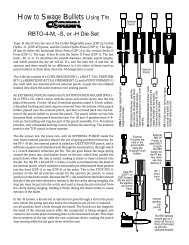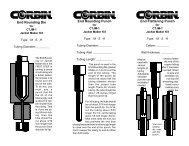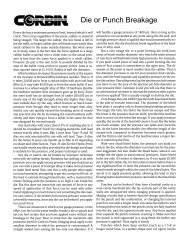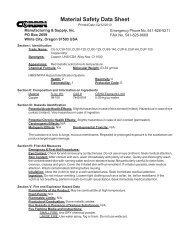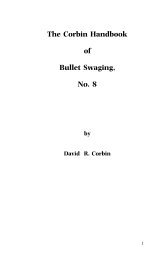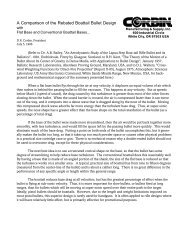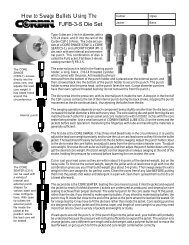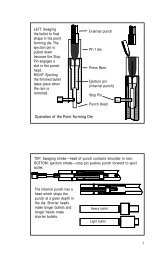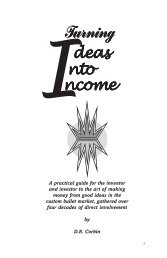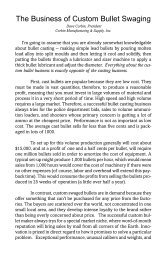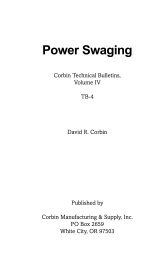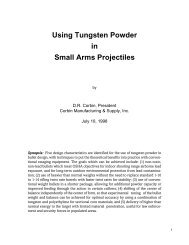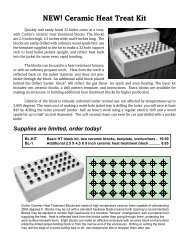HB-9 updated text (PDF) - Corbin Bullet Swaging
HB-9 updated text (PDF) - Corbin Bullet Swaging
HB-9 updated text (PDF) - Corbin Bullet Swaging
Create successful ePaper yourself
Turn your PDF publications into a flip-book with our unique Google optimized e-Paper software.
There are two more steps to expand the core inside the jacket, blowing<br />
the jacket out like the skin of a balloon, and then form the ogive on<br />
the bullet to finish it. That is for flat base open tip bullets.<br />
But if you wanted to make a lead .308 diameter bullet for a .30 Mauser<br />
pistol, then we’d make almost the same kind of die but we’d make it with<br />
a bore of .308 inches, and fit it with the right kind of nose and base punches.<br />
So you see that even if the dies look similar and work in a similar way,<br />
their purpose really makes them different dies. That’s why we need two<br />
different names for them. It helps avoid a lot of unnecessary explanation<br />
and errors.<br />
Perhaps you might order a .308 LSWC die, maybe with an “Autoloader”<br />
nose and a “Cup Base”. We would use the short-hand “AL” for<br />
Auto-loader, a sort of rounded semi-wadcutter shape, and “CB” for Cup<br />
Base, which is a shallow concave base form. To us, the term “semiwadcutter”<br />
is a general description for a bullet style that can be made<br />
using a punch to form the nose, instead of a point forming die. The Target<br />
Wadcutter, Button-Nose Wadcutter, Keith, Auto-Loader, and even round<br />
nose SWC styles are all subsets of the semi-wadcutter group, since every<br />
one of these styles is made in the same die just by changing the nose<br />
punch.<br />
Two other kinds of dies that are made with a straight hole and two<br />
full-diameter punches are the “Lead Tip” die and the “Core Seat” die.<br />
These don’t have any bleed holes around their middle. The core seat die<br />
is also called a “Core Seater” and abbreviated “CS”. The lead tip die is also<br />
called a “Lead Tip Former” and is abbreviated “LT”. It is not the same<br />
thing as a point former or “PF” die.<br />
The purpose of a core seat die is to expand the jacket, which is made<br />
slightly less than final diameter, and at the same time achieve a very tight<br />
fit between the core and jacket. You can use either a punch that fits into<br />
the jacket, to make open tip style bullets, or you can use a punch that fits<br />
the die bore, and thus make large lead tips. The use of a CS die to make<br />
lead bullets (after first swaging the lead core to exact weight in the CSW<br />
die) is a perfectionist’s way to build lead wadcutter or semi-wadcutter<br />
bullets: it can be more precise because you separate the pressure needed<br />
to extrude surplus lead from the pressure required to form the edges of<br />
the bullet nose and base.<br />
In a LSWC die, the pressure stops building when the lead begins to<br />
extrude through the bleed holes. Thus, some shapes of bullets with deep<br />
nose cavities or hollow bases and sharp edges may not receive enough<br />
pressure to fully take on the exact punch shape, if that pressure is higher<br />
than the pressure which causes lead to spurt out the bleed holes. By first<br />
15



